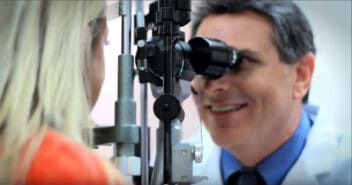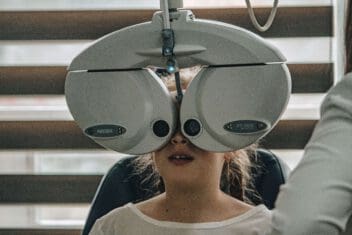
Medically Reviewed by Salwa Aziz, M.D., M.P.H. NVISION Surgeon
All About Open-Angle Glaucoma: Prognosis, Timelines & Treatments
Home / Diagnosed With Glaucoma /
Last Updated:

Medically Reviewed by Salwa Aziz, M.D., M.P.H. NVISION Surgeon

Article At a Glance
Open-angle glaucoma is the most common form of glaucoma, developing gradually and often without early symptoms. It occurs when the eye’s drainage system becomes less efficient over time, leading to increased eye pressure and potential damage to the optic nerve.
While vision loss is permanent, early detection and treatment can prevent further damage. Management options include daily eye drops, laser therapy, and surgery. Regular eye exams are essential, especially if you have risk factors like age, family history, or high eye pressure. With consistent care, many people with open-angle glaucoma can preserve their vision long-term.
Table of Contents
Our bodies – and particularly our eyesight – changes as we get older. While you can expect some normal changes in your vision as the years go by, certain deviations may be a sign of open-angle glaucoma. Potential signs of open-angle glaucoma include blurry vision or an inability to see from the side (also called peripheral vision).
The symptoms of open-angle glaucoma are only noticeable once the damage has been done – and the damage is irreversible, which is why prevention and early detection are key. Monitoring your eyesight, maintaining a healthy diet, and wearing protective glasses if you are an athlete can help you prevent and treat open-angle glaucoma.
Open-Angle Glaucoma: An Overview

Glaucoma is the number one cause of vision loss around the world, and it affects an estimated 70 million people internationally. The majority of glaucoma patients have open-angle glaucoma.
Your eye is composed of a fluid-filled area called the aqueous humor. The fluid in the aqueous humor nourishes the eye and maintains its shape. It needs to be filled and drained constantly to prevent blockages or excess pressure inside your eye.
You deserve clear vision. We can help.
With 135+ locations and over 2.5 million procedures performed, our board-certified eye surgeons deliver results you can trust.
Your journey to better vision starts here.
Two parts ensure the aqueous humor has proper fluid levels:
- The uveoscleral outflow
- The trabecular meshwork (a spongy tissue between the iris and the cornea that filters and drains fluid out of the eye)
Open-angle glaucoma is caused by damage to the trabecular meshwork, the part of the eye responsible for draining fluid. In this type of glaucoma, the angle between the iris and the cornea remains open, allowing the iris to stay in its normal position, and the uveoscleral drainage canals remain unobstructed. However, blockages in the trabecular meshwork lead to increased pressure in the eye, which can damage the optic nerve.
Types of Open-Angle Glaucoma
Primary Open-Angle Glaucoma (POAG)
Primary Open-Angle Glaucoma (POAG) is the most common form of glaucoma and a leading cause of vision loss worldwide. In POAG, the drainage angle formed by the cornea and iris remains open, but the trabecular meshwork—a spongy tissue that allows fluid drainage from the eye—gradually becomes less efficient. This causes a slow buildup of intraocular pressure (IOP), which can lead to progressive optic nerve damage. Most people with POAG experience no symptoms in the early stages, making regular eye exams essential for early detection. Over time, patients may notice a loss of peripheral vision, and if left untreated, the vision loss can eventually impact central vision.
The risk of POAG increases with age, and it’s especially prevalent in individuals over 40. Other risk factors include a family history of glaucoma, African or Hispanic descent, and medical conditions like diabetes or high blood pressure. Treatment for POAG is centered on lowering IOP to prevent further damage to the optic nerve. This typically involves daily use of medicated eye drops, though laser therapy and surgical options may be recommended in more advanced cases or when eye drops are insufficient.
Normal-Tension Glaucoma (NTG)
Normal-Tension Glaucoma (NTG), also known as Low-Tension Glaucoma, is a unique form of glaucoma where optic nerve damage occurs even though IOP levels are within the normal range.
The exact cause of NTG is not fully understood, but reduced blood flow to the optic nerve or increased optic nerve sensitivity may contribute to its development. NTG progresses similarly to POAG, with gradual loss of peripheral vision that may go unnoticed until the condition has advanced significantly.
NTG is more common among individuals of Japanese descent and those with a family history of the condition. Cardiovascular conditions, migraines, and sleep apnea are additional risk factors. Treatments for NTG aim to reduce IOP as much as possible, even though the starting pressure is within the normal range. This may involve a combination of medicated eye drops, lifestyle changes to improve blood flow, and, in some cases, laser or surgical interventions to maintain healthy optic nerve function.
Exfoliative Glaucoma (Pseudoexfoliative Glaucoma)
Exfoliative Glaucoma, or Pseudoexfoliative Glaucoma, is a secondary form of open-angle glaucoma that occurs when a flaky, dandruff-like material accumulates on the eye structures, particularly on the lens and in the trabecular meshwork. This material impedes fluid drainage, leading to increased eye pressure and optic nerve damage over time. Exfoliative Glaucoma can be more aggressive than POAG, progressing more rapidly with fluctuating IOP.
People of Scandinavian descent are more prone to developing Exfoliative Glaucoma, and it often appears in one eye before affecting both. As with other types of glaucoma, Exfoliative Glaucoma is typically asymptomatic in the early stages. Treatments focus on lowering IOP with medications, but due to the potentially rapid progression, laser therapy or surgery is often needed sooner than in POAG cases. Regular follow-ups are critical to monitor IOP and ensure timely intervention.
Pigmentary Glaucoma
Pigmentary Glaucoma arises when pigment granules from the iris break off and obstruct the trabecular meshwork. This pigment accumulation disrupts the normal fluid drainage and increases IOP, leading to optic nerve damage. It’s more common in younger, nearsighted (myopic) individuals, particularly men, and may have a genetic component. Activities that involve vigorous movement, such as jogging or other high-impact exercises, can sometimes worsen this condition as the physical motion shakes loose more pigment.
Symptoms of Pigmentary Glaucoma can include blurry vision, eye pain, or seeing halos around lights, especially after strenuous activities. The primary goal of treatment is to reduce IOP through medicated eye drops, laser therapy, or surgical procedures. Laser trabeculoplasty—a type of laser treatment that targets the trabecular meshwork—can be especially effective in helping to restore drainage and alleviate pressure.
Steroid-Induced Glaucoma
Steroid-Induced Glaucoma occurs when prolonged use of corticosteroids (e.g., in eye drops, creams, inhalers, or systemic medications) leads to an increase in IOP. Steroids can cause structural changes in the trabecular meshwork that reduce its ability to drain fluid efficiently. People with a family history of glaucoma or pre-existing high IOP are at a higher risk for developing this condition when exposed to long-term steroid use.
Symptoms may not appear until IOP becomes significantly elevated, making it important for individuals on long-term steroid therapy to have regular eye exams. The first step in treatment is usually to reduce or discontinue steroid use, if possible. Additionally, medicated eye drops or, in severe cases, surgery may be required to control IOP. With careful monitoring and management, steroid-induced glaucoma can often be reversed or managed to minimize damage to the optic nerve.
What About Narrow-Angle Glaucoma?
Narrow-Angle Glaucoma, sometimes called acute-angle glaucoma or angle-closure glaucoma, is different from Open-Angle Glaucoma. Narrow-angle glaucoma makes up an estimated 20 percent of cases.
In this form of glaucoma, both the uveoscleral canals and trabecular network are blocked, leading to increased pressure in the eye. Learn more about Narrow-Angle Glaucoma, its causes, symptoms, and treatment options here.
Symptoms & Diagnosis of Open-Angle Glaucoma

Symptoms are typically only noticeable once irreversible damage has been done – and the damage is irreversible, which is why eye exams are the best way to prevent or screen for glaucoma. Even when symptoms begin to appear, they come on so gradually that patients often do not notice.
Acute cases of glaucoma may produce symptoms. Talk to your eye doctor if you identify any of these symptoms:
- Tunnel vision: This occurs when your peripheral vision gets so bad you cannot see well or at all from the sides, even if your general wide-angle vision is fine.
- Cloudy or patchy peripheral vision: Your peripheral vision is beginning to be restricted.
- Unresponsive pupils: Your dilated pupil may not change even in different light conditions.
- Redness: Red areas in the white part of the eye can be a sign of glaucoma.
These symptoms are most common to narrow (or acute) angle glaucoma, but they can appear with open-angle glaucoma as well. Glaucoma can also be free of symptoms.
If these symptoms appear or persist, your doctor will give the following tests to detect and diagnose open-angle glaucoma:
- Visual field test (perimetry)
- Checking the eye’s drainage angle (gonioscopy)
- Optic nerve evaluation (ophthalmoscopy)
- Eye pressure measurements (tonometry)
You deserve clear vision. We can help.
With 135+ locations and over 2.5 million procedures performed, our board-certified eye surgeons deliver results you can trust.
Your journey to better vision starts here.
Will I Go Blind from Glaucoma?

A study shows that people who were diagnosed with glaucoma between 1981 and 2000 fared better than patients diagnosed between 1965 and 1980. Some theories on why those diagnosed in more recent years fare better include:
- Increased knowledge about the progression of glaucoma and its risk factors.
- Medical and surgical innovations that enable patients to get better treatment.
- Development of new procedures that are effective in managing glaucoma.
- Changes in criteria for diagnosis that allow for earlier detection.
Glaucoma can still cause blindness or severe vision loss if untreated, but your odds of becoming blind are low if you are diagnosed early.
Scientists are still researching the progression of glaucoma, and timetables vary from one person to the next. It’s important to be under the care of an ophthalmologist who can give you a more specific timeline of what to expect for your case.
Treatment & Prognosis of Glaucoma

The damage caused by glaucoma is irreparable, but if glaucoma is detected early, you can prevent or lessen serious symptoms, such as vision loss.
Damage caused by glaucoma is irreparable. Treatment only helps to control the condition and prevent further damage.Treatment for glaucoma may consist of medications, laser treatments, or traditional surgery.
- Medication: Eye drops are the most common way glaucoma can be treated. Some of these eye drops decrease intraocular pressure by ensuring fluid can drain out properly. Others decrease the amount of aqueous fluid your eye makes. Eye drops can cause side effects, such as itching, stinging, redness in or around the eyes, dry mouth, eyelash growth, or blurry vision. Tell your doctor about any medications you currently take, and do not stop using your eye drops without consulting with your doctor first.
- Laser eye surgery: This is typically performed in an outpatient center or ophthalmologist’s practice. Individuals with open-angle glaucoma usually get a trabeculoplasty. This procedure uses a laser to help the trabecular mesh better drain itself to decrease eye pressure.
- Traditional or operating room surgery: Surgical procedures are conducted in an operating room. There two procedures that can help patients with glaucoma.
- Glaucoma drainage services: A small tube is implanted in the eye to divert fluid and send it to a reservoir, or collection area. Your surgeon will create this collection area behind the thin layer covering the white part of the eye and the inside your eyelids, or conjunctiva. This will ensure blood vessels absorb excess fluid back into your body.
- Trabeculectomy: In this procedure, your surgeon cuts a minuscule flap in the white of the eye, or sclera. Next, a pocket called a filtration bleb is created in the conjunctiva. This bleb is typically beneath the upper part of your eyelid. Aqueous humor can drain out of the eye and into the bleb via the flap to relieve pressure.
If you have already been diagnosed, prescribed a medication, or had surgery, it is vital that you follow directions for medication and aftercare. This will prevent symptoms from becoming worse.
People with a confirmed diagnosis of glaucoma can expect to visit their ophthalmologist every three to six months. The length of time between visits varies, depending on your needs. If your open-angle glaucoma worsens, your doctor may change your treatment regimen or recommend glaucoma surgery.
Make sure to get regular eye exams, know your family’s eye health history, and wear protective gear to ensure good overall eye health.
Frequently Asked Questions
What is open-angle glaucoma?
Your eye needs to drain its aqueous fluid correctly, so you do not feel any pressure. It does so by using the trabecular meshwork and outflow from the uveoscleral coat. Open-angle glaucoma results from a blockage to the trabecular meshwork that increases pressure and begins to damage your optic nerve. Left untreated, this increased pressure could cause vision loss, eventually progressing to blindness.
How is open-angle glaucoma detected and diagnosed?
Regular eye exams can help your eye doctor notice any changes to your vision. An ophthalmologist can screen for glaucoma and order additional tests if symptoms are present. You will be asked to share your medical history, as glaucoma is more likely in patients with a family history of the condition.
Four types of tests can detect and diagnose open-angle glaucoma: visual field screening, pressure measurements, evaluation of the optic nerve, and an examination of the drainage angle.
What types of treatment can I expect?
Eye drops are the most common medication used to control glaucoma and relieve eye pressure.
Laser eye surgery is another alternative. A laser is used to help the trabecular mesh drain your eye to relieve intraocular pressure.
Traditional surgery is another option for patients with open-angle glaucoma. This is usually the last resort after less invasive treatment options prove ineffective.
Follow directions from your doctor, and use your medications as prescribed. Depending on the severity of symptoms, you may need more than one type of treatment. It is normal to see your ophthalmologist more often after surgery to ensure your treatment is effective.
You deserve clear vision. We can help.
With 135+ locations and over 2.5 million procedures performed, our board-certified eye surgeons deliver results you can trust.
Your journey to better vision starts here.
References
- Symptoms of Open-Angle Glaucoma. (October 2017). Glaucoma Research Foundation.
- Glaucoma Overview. See International.
- Glaucoma. (July 2019). National Eye Institute.
- Glaucoma Treatment. (August 2019). American Academy of Ophthalmology.
- Glaucoma. Kellogg Eye Center, University of Michigan.
- What Are Symptoms of Glaucoma? (May 2019). American Academy of Ophthalmology.
- Vision Changes as We Age: What’s Normal? What’s Not? (September 2016). University of Utah.
- Incidence and Probability of Progression to Blindness Due to Open-Angle Glaucoma Decreases Dramatically. (May 2014). Mayo Clinic.

Dr. Salwa Aziz is a board-certified ophthalmologist and fellowship-trained Glaucoma Specialist who specializes in the diagnosis and treatment of simple and complex Cataracts and Glaucoma. Dr. Aziz treats Ocular Hypertension, Primary Open Angle Glaucoma, Narrow Angles, Primary Angle-Closure Glaucoma and Secondary Glaucoma. Dr. Aziz utilizes medical and laser treatments, minimally-invasive glaucoma surgery (MIGS), complex glaucoma surgeries, including Trabeculectomies, Trabeculotomies and Glaucoma Shunt Implants. Dr. Aziz also specializes in vision correction with premium intraocular lens implants and advanced technology cataract surgery.
This content is for informational purposes only. It may have been reviewed by a licensed physician, but is not intended to serve as a substitute for professional medical advice. Always consult your healthcare provider with any health concerns. For more, read our Privacy Policy and Editorial Policy.

